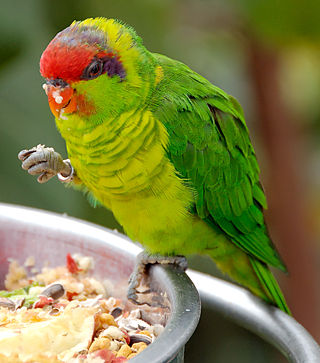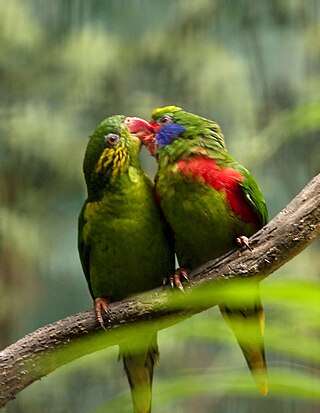
Loriinae is a subfamily of psittacine birds, one of the six subfamilies that make up the family Psittaculidae. It consists of three tribes, the lories and lorikeets (Loriini), the budgerigar (Melopsittacini) and the fig parrots (Cyclopsittini), which are small birds, mostly of bright colors and inhabitants of Oceania and the islands of Southeast Asia.

The New Caledonian lorikeet is a potentially extinct lorikeet endemic to the Melanesian island of New Caledonia.

The red-throated lorikeet is a critically endangered lorikeet endemic to Fiji. It is 18 cm long and is bright green overall, with red cheeks, throat and thighs.

The iris lorikeet is a small, up to 20 cm (8 in) long, green lorikeet bird. The male has a red forehead, yellow nape, purple band back from eye between nape and cheek, and yellowish below. The female almost similar with red-marked green forecrown and yellowish green cheek.

Josephine's lorikeet is a species of parrot in the family Psittaculidae. It is found in the highlands of New Guinea . Its natural habitats are subtropical or tropical moist lowland forest and subtropical or tropical moist montane forest.

Charmosyna is a genus of parrots in the family Psittaculidae. The three currently recognized species inhabit moist forests on the island of New Guinea.

The duchess lorikeet is a species of parrot in the family Psittaculidae. It is the only species placed in the genus Charmosynoides. It is found throughout the Solomon Islands archipelago. Its natural habitats are subtropical or tropical moist lowland forest, subtropical or tropical moist montane forest, and plantations. It is threatened by habitat loss.
The striated lorikeet, lori strié, or lori estriado is a species of parrot in the family Psittaculidae native to New Guinea. It is the only species placed in the genus Synorhacma. It is threatened by habitat loss.

The red-flanked lorikeet is a species of parrot in the family Psittaculidae. It is found in Mollucas, New Guinea and the Bismarck Archipelago. Its natural habitats are subtropical or tropical moist lowland forests and subtropical or tropical mangrove forests. Only the adult males have the red plumage on the head and sides.

The fairy lorikeet is a species of parrot in the family Psittaculidae. Other common names include the little red lorikeet and the little red lory. Found in New Guinea, its natural habitats are subtropical or tropical moist lowland forests and subtropical or tropical moist montane forests. Its colouration is mainly red with some yellow on the throat and green on the wings. Two subspecies are recognised, C. p. pulchella and C. p. rothschildi.

The red-fronted lorikeet, also known as the red-spotted lorikeet or red-rumped lorikeet is a species of parrot in the family Psittaculidae. It is found in northern New Guinea and the island of Biak. Its natural habitat is subtropical or tropical moist montane forests.

The orange-billed lorikeet is a species in the Old World parrot family Psittaculidae. First described by the German ornithologist Ernst Hartert in 1896, it is endemic to New Guinea, where it mainly inhabits cloud forest, forest edges, and cleared areas bordering forests at elevations of 2,100–3,800 m (6,900–12,500 ft). Adults are 18 cm (7.1 in) long on average and weigh 25–40 g (0.88–1.41 oz), and are mainly green in color, with a red underside and narrow yellow streaking on the cheeks. It looks similar to the closely related yellow-billed lorikeet, but is smaller in size, has more richly coloured plumage, and has a smaller, orange bill.

The collared lory is a species of parrot in the family Psittaculidae. It is endemic to the islands of Fiji. It is the only Fijian rainforest bird to adapt to urban landscapes and can be found in urban Suva. Measuring 20 cm (7.9 in), it has bright red underparts and face with a purple crown and greenish upperparts. Males and females are similar in plumage, although the latter have a paler crown.

Goldie's lorikeet is a species of parrot in the family Psittaculidae. It is the only species placed in the genus Glossoptilus. It is found in forest and woodland in New Guinea, primarily at altitudes of 1000–2200 m. It is mostly green with yellowish streaks in the chest area, and a red, blue and purple head. It is a small bird measuring 19 cm in length and weighing 45–60 grams.

The Mindanao lorikeet or Mount Apo lorikeet is a species of parrot in the family Psittaculidae. There are two very similar subspecies, which are both endemic to Mindanao, Philippines.

The ornate lorikeet, sometimes named the ornate lory, is a species of parrot in the family Psittaculidae. It is endemic to the Sulawesi archipelago in Indonesia. It is found in forest, woodland, mangrove and plantations, and is locally common.

Hypocharmosyna is a genus of parrots in the family Psittaculidae that are endemic to New Guinea, the Maluku Islands and the Bismarck Archipelago.















